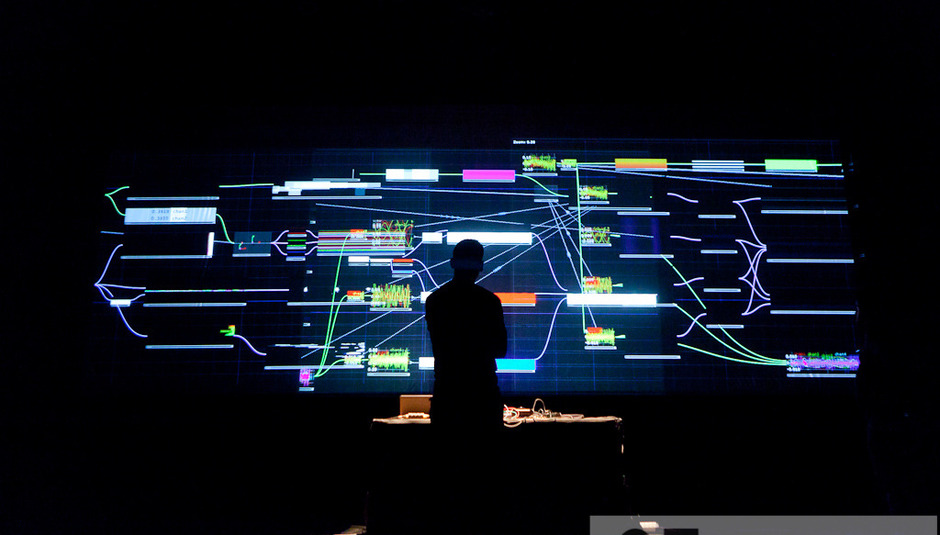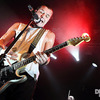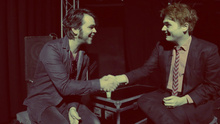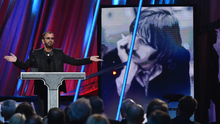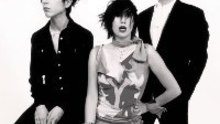Photo by Adriano Ferreira Borges
The small northern Portuguese city of Braga prides itself on having a hundred ways to prepare cod; it also seems to have at least one church for each recipe. Locals are quick to tell you about their football stadium, a threatening monolith carved into the side of a rock, referred to by Barack Obama when he handed its architect the Pritzker Prize earlier this year. It is the oldest city in the country and was home to the Archbishop who bent a Prince’s ear and instigated the state’s succession from Spain in the twelth century. And for one weekend in November, Braga was the world capital of electronic music, proclaimed such by one of Portugal’s most respected broadsheets.
The reason for the city’s brief reign was Semibreve Festival, an acutely programmed audio-visual showcase for some of the finest electronic musicians working today. In the event’s first edition, organisers assembled an impressive cast of performers and placed them in a pair of stunning venues. It was an excellent ploy, one garnering an impressive turnout and the beginnings of an exceptional reputation.
A series of discussions and talks in a thousand-year-old monastery on the edge of town acted as a curtain-raising event for the weekend’s thrills. In front of a small but engaged audience, Portuguese laptop performer Vitor Joaquim began proceedings by presenting what amounted to a thesis derived from the central paradox of going to see (rather than hear) music. It set off some heating debate, neatly put to bed by electronic pioneer Hans-Joachim Roedelius’s assertion that his music speaks for itself.
That is exactly what it did the next night, as Qluster - Roedelius’s recent collaboration with analogue whizz Onnen Bock - were first on stage in the beautiful Theatro Circo, a kind of Iberian Carnegie Hall in the town centre. Ambient textures ebbed and flowed, occasional sequenced rhythm patterns undercutting the meandering sense of drift. The sonic palette Roedelius has engaged with since the late-1960s were fully in evidence - glacial murmurs, oceanic pulses, futuristic drones – and he twice added some acoustic force, taking to the venue’s extremely grand piano to eek out subtle melodic lines. The performance was well-matched by visuals from Viennese duo Luma.Launisch that built cryptic pictures from the simple situations like seaside holidays and parks in full bloom.
Next up, a duo consisting of American Taylor Deupree and German Stephan Mathieu had steadfastly refused to perform with any visual accompaniment, but nonetheless made a startling visual impact in the downstairs studio space. Each dressed all in black with their bald pates lit by a single spotlight they looked a pair of monastic twins. Their music, a gracious drone gradually bent and shaped while prodded by subtle electronic interventions, was equally singular and equally striking.
Jon Hopkins’ schizophrenic set bestrode skittering beats, tumbling basslines and delicate Satie-like miniatures. He was another musician utilise the piano, this time in a manner peculiarly effective in such reverent surrounds. He shifted between full blown banging beats and unaccompanied piano tunes in much the way Aphex Twin did a decade ago with drukQs. Live this would appear an even greater challenge, but the consistence of his output - in a set largely culled from his 2009 album Insides - saw him achieve it with aplomb. His dexterity at the keyboard, demonstrated on gentle harmonies of ‘Small Memory’, was equally in evidence as his fingers danced balletically across the electronic equipment he had laid out. He built a head of John Carpenter arpeggios, tumultuous rhythms and driving melodies, at times nursing triple threat of bass feeds - no sooner were they all at full health than he alternately muffled each to maintain a perpetually renewed bass rush. Suitably the visuals began with a stream of multicoloured spatters resembling Rorschach tests - I saw bulls, blindfolded ninjas and fedoras, but then again I’m psychologically damaged.
In front of intense walls of light from Portuguese video artist p.ma, Fennesz unfurled a dense cloud of noxious static on the second night, filling the assembled ears with the extraordinary sounds he conjures from guitar, effect boxes and Macbook. A true original, his unique music - guitar processed to the brink of infinity – was a waking dream. When the glorious clear riff from ‘Liminal’ (from his recent Seven Stars EP) broke through he attained a peak of beauty in a performance that made 45 minutes pass like a blink and left an audience eager for more.
Portuguese act Blac Koyote’s had an unusual set up featuring two laptops and two percussionists, but successfully maintained a perfect equilibrium between each. Admirably, the drummers were as happy to remain silent as to produce a fully formed freak out, and the quartet’s breezy electronica, reminiscent of late-period FSK, was an unexpected delight over a series of honed post rock workouts concluding in an all out battering of skins.
In the year his label, Raster-Noton, has been celebrating its 15th birthday Carsten Nicolai, aka alva noto, has unleashed perhaps his finest output with the album univrs and its accompanying live show. The visuals - real time manipulated imagery individuated for each track and presented like components on a motherboard - merely confirm the meticulousness with which the whole was created. Exploiting the glitches and elements a nod to sub-bass along with minimal’s standard armoury, his sustained assault of manipulated rhythm was alive with ideas. Amongst the many highlights, ‘uni acronym’ sees Anne-James Chaton’s mechanical intonations of an alphabetical list of three-letter acronyms throwing up some unexpected collisions (“KFC, KGB, KLF”) as each accompanying logo flickers across the screen. The imminently danceable set may seem more appropriate to an industrial warehouse than a cosmopolitan concert hall, but it is still a stunner.
The final night saw early performances from just two acts. Calling themselves Filament, Vitor Joaquim and Madeiran visual artist Hugo Olim sampled spoken words from John Cage and news reports of French high-wire artist Philippe Petit, and visuals grabbed from an onstage microscope. Lyrical hums gave was to claustrophobic atmospherics and on to frozen warnings. The combination felt occasionally over thought, but a series of light triggers laid across the stage produced a pulsating finale.
Murcof arrived with a well-tested three dimensional light show from AntiVJ: a monochrome projection of lines unfolding into never quite defined monsters. It was an impressive sight which the music - calm sonic flows sometimes bestrode by regulated pulses - seem no more than an accompaniment, a soundtrack. The festival, it seemed, had come full circle: was this music that you couldn’t just hear but were also required to see?
All of which is to say that Semibreve is proved cut above the average first time fest. With added installations and series of oddball additional onsite performances (artist Vitor Lago Silva strange robotic act in what he calls a “Wireless Sensitive Suit” the most memorable) showing the inquisitive nature of the programmers, it proved a place to think as well as lapse into musical reverie. Wilfully intellectual, superbly run, and with a passion in everything it did, Semibreve deserves the accolades of the Portuguese press and a regular place in the wider world’s musical calendar. Braga now has one more thing to be famous for…

